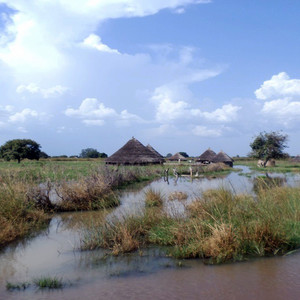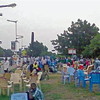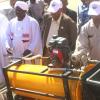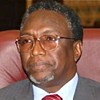Stake a Claim
Land problems in Sudan are many and contentious land laws have prompted much of the population, in the midst of conflicts, to abandon their homes and resettle in the capital.
Pre-2011 Sudan was the largest state in the Arab world and the African continent. Since the secession of South Sudan, however, Sudan has become the third largest country in Africa, with an area of circa 1.9 million square kilometres.
There are approximately 85 million hectares of arable land; pastures and forests occupy nearly 117 million hectares and the rest is made up of desert land.
The land is owned by God and the state is a successor.”Nearly 80 percent of the population lives off the land, yet most people have little claim to the land they cultivate.
Under the current laws, the government owns the land and the citizens effectively rent it from the government under the Quitrent Law. This applies to agricultural, residential and commercial lands.
Citizens may gain the right to land ownership through the so-called Search Certificate, which is obtained from the Land Department after proving the right of ownership, which then allows citizens to use the property for housing, cultivation or to sell it.
The dialectical evolution of land ownership in Sudan
In his book ‘Land Relationships In Sudan’, late communist leader Mohamed Ibrahim Nugud explained that land in the era of the Fur and the Funj sultanates was absolutely owned by the Sultan, politically and legally”, and the political and social forces allied with the state controlled the land through land and production feudality via the rulers”.
LEGAL BACKGROUND
There is no unified legal framework of land tenure in either country. Rather, two parallel systems exist in both Sudan and South Sudan respectively: the legal statutory system and the indigenous system of tenure based on customary rights. In Sudan, legislation is essentially founded on colonial land laws. Since independence in 1956, successive laws and decrees have undermined the land rights of rural communities, small farmers and pastoralists in favour of rural entrepreneurs, urban dwellers, foreign investors and elite groups. The most notable was the Unregistered Land Act of 1970, now repealed, in which unregistered land was to go to the State and could not be acquired through long-standing use. Expropriations were common, particularly in South Kordofan.During the Anglo-Egyptian Condominium, land was organised after enacting the Land Ownership Law in 1899. Through this law, customary possessions that governed land ownership and registration were legalised, and controls of land surveys and registration procedures for individuals were identified for the first time in the modern history of Sudan.
Sudanese lands were divided into two parts: government land, to which members had no right (wastelands, forests or uninhabited lands), and government land under customary usufruct rooted in society, such as clans, villages, or individuals in special cases. Since the latter were not registered, the government had the right to expropriate them if necessary.
The Land Ownership Act of 1903 gave the government powers to expropriate lands for irrigation projects or other public purposes. After more than a dozen other laws, Sudan reached the Civil Transaction Act of 1984, which stated Land is owned by God and the state is a successor and responsible for land and its owner. All lands of any kind that were not registered before the effective date of this law shall be deemed registered in the name of the State.” The act also identified the process, where No property shall be expropriated other than for the public benefit in return for just compensation”.
Through all these laws, citizens found themselves in direct confrontation with the government of the day. The act of 1984 explained that expropriation could only be carried out through mutual consent with the citizens, via compensation, often by giving them alternative land. In the case of Northern State, the population’s lands were expropriated to establish the Aswan High Dam in the 1960s, but many residents did not accept resettlement in remote regions.
Conflict in South Kordofan, Blue Nile and Darfur is another interface of disputes over land. In South Kordofan, for example, elitist groups acquired large tracts of land through political cronyism, forcing the Nuba farmers to become workers in large agricultural schemes, without owning the land they deemed their right. This led to the destruction of the bonds of peaceful coexistence between the Nuba and the Baggara clans.
Land expropriation in Khartoum State
The stage of most state-citizen conflicts is open fields and lands registered as reserves, as people using them consider that the state is seizing their rights,” says Khartoum’s Governor Abdul Rahman Al-Khidr.
There are three types of lands in Khartoum State: historical lands; lands which the state may use as reserves for services or compensation; and open spaces, which amount to 1,000 fields registered in the name of the Ministry of Youth and Sports and cannot be exploited at all.
Ten years later, the authorities displaced us to the capital outskirts, a procedure that is unfair.”
The government has formed a committee in order to reconcile the historical land issue, says Khidr. It has settled around 80% of the cases,” he claims, however, he recognises additional problems: How long will the state compensate those people through previous and current generations?”
Despite the government’s persistent efforts to remedy the problem, observers suggest it is at fault for such conflicts because, as part of its search for resources, the government sells lands to foreign investors without first considering citizens’ rights.
For example, the clashes in Um Dom area this past April were caused by a conflict over agricultural lands awarded to a Saudi investor, while the residents in the area consider the land their historical right.
The government is also accused of addressing the problem after it occurs, especially in squatter settlements, since it does not prevent citizens from building houses on empty spaces or from exploiting them in agriculture.
Omar Abdulqader, an internally displaced person who was deported by the authorities from Ombda to Omdurman, says he settled down in the area after he came from Darfur. The authorities did not call him to any account for illegally occupying state-owned land. On the contrary, he says, Some officials registered us and said they would give us residential lands in the area.”
Ten years later, the authorities displaced us to the capital outskirts, a procedure that is unfair,” complains Abdulqader, suggesting that the areas they were moved to were remote, not serviced, and void of any building, while construction was expensive.
The government is frequently criticised for these procedures by human rights organisations. A number of lawyers and observers say the way to address these conflicts is to amend existing laws. Although the Land Act takes into account the historical attachment of people to their land, the government has the last word on ownership.






